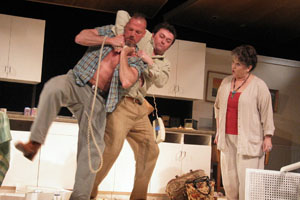
Live theater at the Southampton Cultural Center continues to impress and astonish—this time out with an outstanding production of “True West” by Sam Shepard.
Directed by Michael Disher, this challenging play stars Kirk Gostkowski and Joe Pallister in the leading roles of embattled brothers who meet after years of estrangement. Mark Strecker, as a Hollywood producer and Vay David as “Mom” play smaller but crucial parts. This cast of four is called upon to tackle some of life’s largest questions, up to and including the nature of humankind.
Are some people born good, and some evil, as in the legend of Cain and Abel? Do opposites really have a fatal attraction for each other? And what, the playwright demands to know, is a “true-to-life story?” Is a sensitive love story told in an artistic “film” truer than a good old-fashioned western “movie?”
Why does a cliché (“I know this prairie like the back of my hand”) sound so much better than the literary but ludicrous alternative, “I am on intimate terms with this prairie”?
At the core of the action are the brothers—Mr. Gostkowski as Austin, a settled, college-educated, middle-class screenwriter on the verge of success, who is trying to finish up a project while house-sitting for Mom; and Mr. Pallister as Lee, a beer-chugging, foul-mouthed punk with a sunburn and a Mohawk.
The setting is California, 1979. As the play opens, Lee’s sudden arrival has already upset the peace of the spotless, white-formica kitchen where Austin, formally dressed in a collared shirt and V-neck sweater, tries to concentrate at his typewriter. Lee prods and pokes, verbally and physically, digs around in cupboards, leans over Austin’s shoulder to make sarcastic comments, asks for the loan of Austin’s car, complains. The crickets annoy him more than the coyotes howling nearby.
Austin is placating and somewhat fearful of his aggressive brother, but gets angry—exactly as Lee intended. A truce is negotiated. Austin gives up his car keys; Lee goes “on a little tour” to see what he can steal from the neighbors.
These brothers are as different as can be, right? Not really. Each will reveal frustration and jealousy, sympathy and caring, anger flaring into murderous fury in equal measure as they fight out their complex relationship in nine scenes and two acts.
Conflict erupts very soon, when a Hollywood producer who has shown interest in Austin’s play visits to discuss “the project.” Saul Kimmer, played by Mark Strecker, is smooth and encouraging. He is confident he can get Austin’s script off the ground. But he has not counted on Lee, who bursts into the meeting, toting a stolen television set. Of course Austin had bribed him to stay out of the way; of course he had promised.
To Austin’s horror, he now bullies and cajoles the producer into listening to his own projected movie: a “true western” in which cowboys chase each other in pickup trucks and “gooseneck” cattle trailers. “Ridiculous,” scoffs Austin. The producer says he always goes with his “gut feeling.” Lee’s story is “hot”—millions of dollars could ride on it.
And the battle is on for real.
Austin and Lee are on stage in every scene, for a total of nearly two hours, as they wrangle over what Austin sees as betrayal, Lee as justified triumph. It is a tribute to the playwright and a stellar accomplishment by the actors that this volatile scenario does not deteriorate into sodden grimness.
Saturday evening’s audience seemed attentive to every word, laughed at the considerable number of jokes and wisecracks, not all of them dark. Some of the humor, indeed, is surprising. Is there really something funny about false teeth lost in a bag of Chinese take-out? There was on Saturday.
In the course of their showdown, the brothers reveal their similarities and shared past. At some point in their boyhood, each has wanted to be the other. Austin finds Lee’s life as a fugitive in the desert “adventurous.” Lee, who can hear the characters in his movie talk in his head, envies Austin’s Ivy League education. Without Austin’s professional expertise, he can’t write his own screenplay.
Roles are reversed as they try to sort it out—one screenplay or two? Which of the two, and why? They take turns trying to comfort each other, repeating lines of dialog first spoken by the other: “Don’t worry about me, I can take care of myself.”
Mom enters late in the play, when the brothers’ fury has reached its heart-stopping flashpoint. She appears both concerned and resigned. Sibling rivalry is nothing new. She tells “the boys” to go outside if they must fight.
The play ends, but not the story. Mr. Shepard has not provided prettily tied-up solutions. Conflicts have not gone away; questions still torment. It’s a true-to-life story.
Mr. Disher’s direction, set and costume designs are as brilliant as ever. The action is kept moving tautly and suspensefully. Scene changes happen swiftly and without fuss, assisted by dramatically effective lighting designed by Sebastian Paczynski. Several people are credited as being responsible for props. Whoever found the manual portable typewriter should receive a special commemorative ribbon.
Mr. Gostkowski, who is based in New York, and Mr. Pallister, who has appeared in many local productions, gave truly outstanding performances, never losing an ounce of energy or intensity in their demanding roles. Mr. Strecker, making his first appearance on the Cultural Center stage, was convincingly suave as the movie producer. Ms. David, who has worked with Mr. Disher for many years, made the most of her short but important part.
A standing ovation rewarded the cast. It was well deserved, and the audience should have been much larger. This production of “True West” ought to be seen and appreciated, and the Cultural Center, its directors and sponsors should again receive thanks for producing top quality live theater.